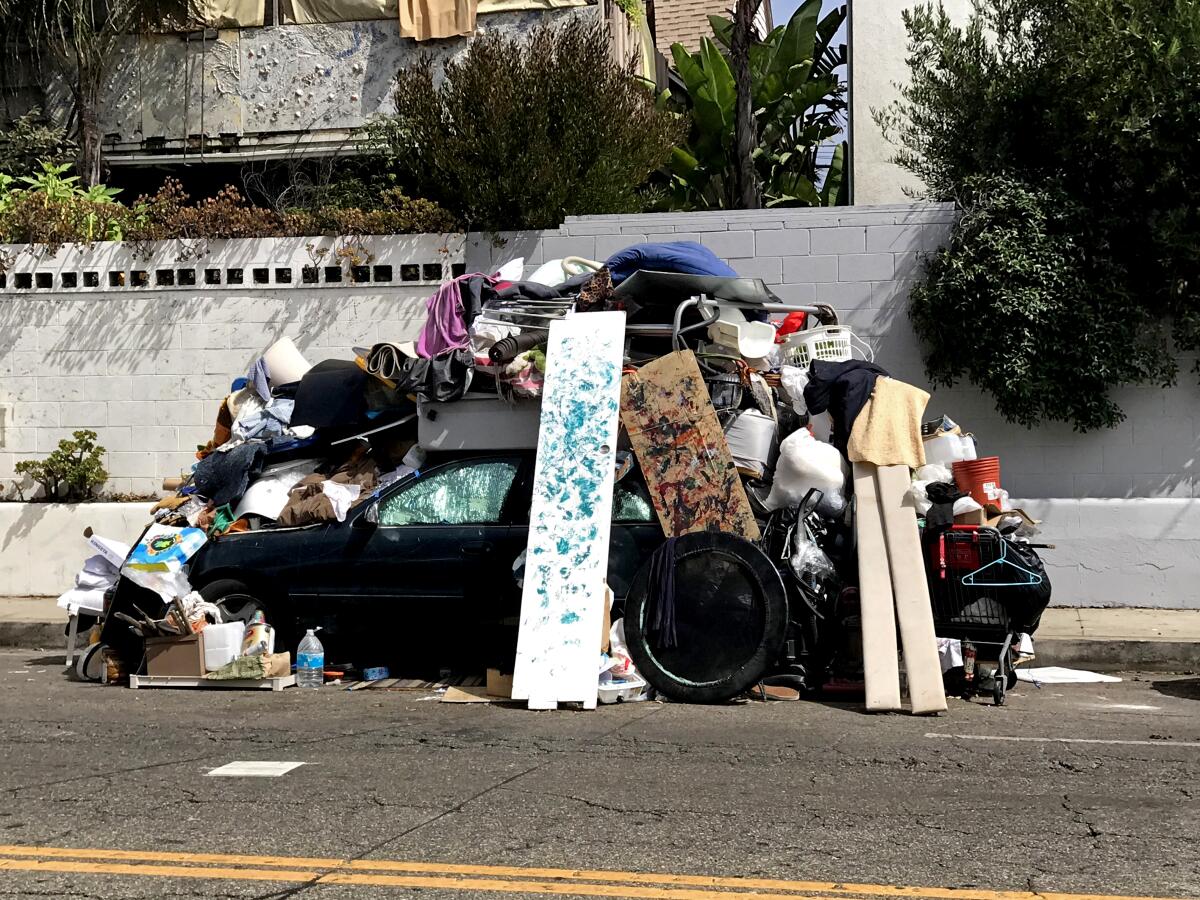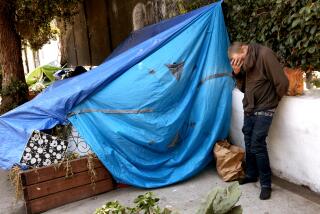Column: Amid the burgeoning homelessness crisis in Venice, some encouraging news

- Share via
I’ve spent most of the last eight months confined to my neighborhood, Venice Beach, which has one of the city’s largest populations of people who are homeless.
I have watched as incredibly resourceful street dwellers have built their own ramshackle homes on sidewalks and small traffic islands, complete with gas barbecues.
I have driven in amazement along Rose Avenue past a nearly half-mile-long homeless encampment on the south side of the Penmar Golf Course, an area neighbors began calling “Skid Rose.” By October, nearly 100 people had taken up quarters there. They cooked and warmed themselves near open fires that regularly got out of control, burning down tents and scorching low-hanging trees edging the golf course.
“There were endless horrific moments,” said Chie Lunn, 42, a mother of two young children who moved into her home on Rose Avenue just about the time the encampment was exploding. Days were difficult but nights were the worst.
“A woman screaming because someone was trying to kill her by lighting her tent on fire. You would hear every vulgar thing you could imagine. The amount of people defecating on your front door step. You are struggling between this path of caring, and wanting them to get the help they need, but understanding your family needs to be secure.”
Because of COVID-19 precautions, various court decisions and actions taken by the Los Angeles City Council, homeless people have had unprecedented levels of protection for most of the year.
Venice’s famous Ocean Front Walk has become a sea of tents. And I watched in amazement and horror for months as a man on Pacific Avenue, the main north-south thoroughfare near the beach, buried his parked Nissan Altima under so much trash and junk you could no longer tell what color the car was. Sometimes, the detritus spilled into the roadway, and you saw cars swerve, brake hard or slow down to take a picture of the unholy mess.
To the extent that the government should help, not harass, homeless people, I support the protections that have prevented simply razing the encampments. But the situation has become untenable, a barometer of how we deal with people who cannot take care of themselves.
The problem that I, and so many others, have with the explosion of sidewalk tents, ramshackle lean-tos and seriously unsanitary conditions is that we should be better than this.
We are not a third-world country. Why have we allowed ourselves to become one?
In Venice, some fed-up residents have begun surreptitiously taking matters into their own hands.
One day, I noticed a handful of people relandscaping a parkway on South Venice Boulevard near the local library. They were building berms that made pitching tents difficult on the flat strip of land between the sidewalk and the curb, a strip of land that had been attracting an increasing number of tent pitchers. Within days, the city ploughed the renegade berms, restoring — for lack of a better word — campability on the parkway.
After a lean-to on a traffic island at Washington Way and South Venice Boulevard went up in flames, neighbors rushed to construct planters in a star shape on the now-bare asphalt, a way of warding off new would-be occupants.
“Making someone’s situation uncomfortable for a specific location isn’t helping the issue,” said Victor Hinderliter of the Los Angeles Homeless Services Authority. “I get the neighbors’ frustrations, but if you are forcing someone to move from one part of the sidewalk to another, that is not part of a holistic solution.”
It’s also not strictly legal.
But here is some good news:
Last month, the car on Pacific Avenue was moved to a safe parking spot. Councilman Mike Bonin’s office was able to provide its owner a new battery just in time for Oct. 15, when the Los Angeles Police Department began enforcing parking regulations that had been frozen since March.
And Skid Rose, to the relief of its neighbors, is history.
It turns out the need to trim those vulnerable trees provided a spark of urgency.
St. Joseph Center, the Venice-based charity started nearly 45 years ago by two Catholic nuns, coordinated an extraordinary, months-long effort to move the campers of Skid Rose into housing.
Teams funded by the offices of L.A. County Supervisors Sheila Kuehl and Mark Ridley-Thomas helped coordinate operations between the city and county. Bonin’s office was deeply involved, as were the LAPD, the city sanitation department, Parks and Rec, LAHSA and even the Urban Forestry Division of the Bureau of Street Services.
Many mornings in September and October, I would drive along Rose Avenue and see St. Joseph workers in purple shirts on the scene, trying to figure out what kind of services and persuasion the folks in tents needed to accept their help.
And then, the tents began disappearing, replaced by tall chain-link fencing that remains to this day. On Oct. 26, the last tent came down.
So far, said Va Lecia Adams Kellum, chief executive of St. Joseph Center, 72 people living in 59 tents have been housed and are receiving the kind of social services aimed at helping them stay off the streets. She attributes much of the success of the effort to local homeowners, who had come to know their unhoused neighbors across the street and were able to give guidance on who was most in need of help. “They were so caring,” she told me.
I often hear people complain that homelessness is out of control, that the city is doing nothing and the problem is only growing worse.
But some things are moving in the right direction, from solving relatively small issues, like finding safe parking for the guy who lived in his debris-strewn car on Pacific Avenue, to larger ones, like the dismantling of the encampment on Rose Avenue while also helping its residents into housing.
On the day the tents were finally gone, Lunn told me, her 10-year-old son cried in relief because he could finally sleep with his windows open.
“We now have a sense of safety and security that we didn’t even know we were missing,” she said.
And so, we hope, do the formerly homeless folks who finally have a place to lay their heads.
More to Read
A cure for the common opinion
Get thought-provoking perspectives with our weekly newsletter.
You may occasionally receive promotional content from the Los Angeles Times.











